If you would like your weblog posts to get search site visitors, optimize them for Search engine optimization.
However that doesn’t imply shoehorning as many key phrases as potential. Key phrase stuffing doesn’t work anymore.
How do you optimize your content material to be search-friendly? You’ll find out how on this put up.
If nobody’s looking for your key phrases, you usually can’t get search site visitors.
So earlier than you do any content material optimization, you need to first make sure you’re focusing on subjects persons are looking for.
Right here’s find out how to discover these subjects:
- Go to Ahrefs’ Key phrases Explorer
- Enter one or just a few related key phrases
- Go to the Matching phrases report
- Set the tab to Questions
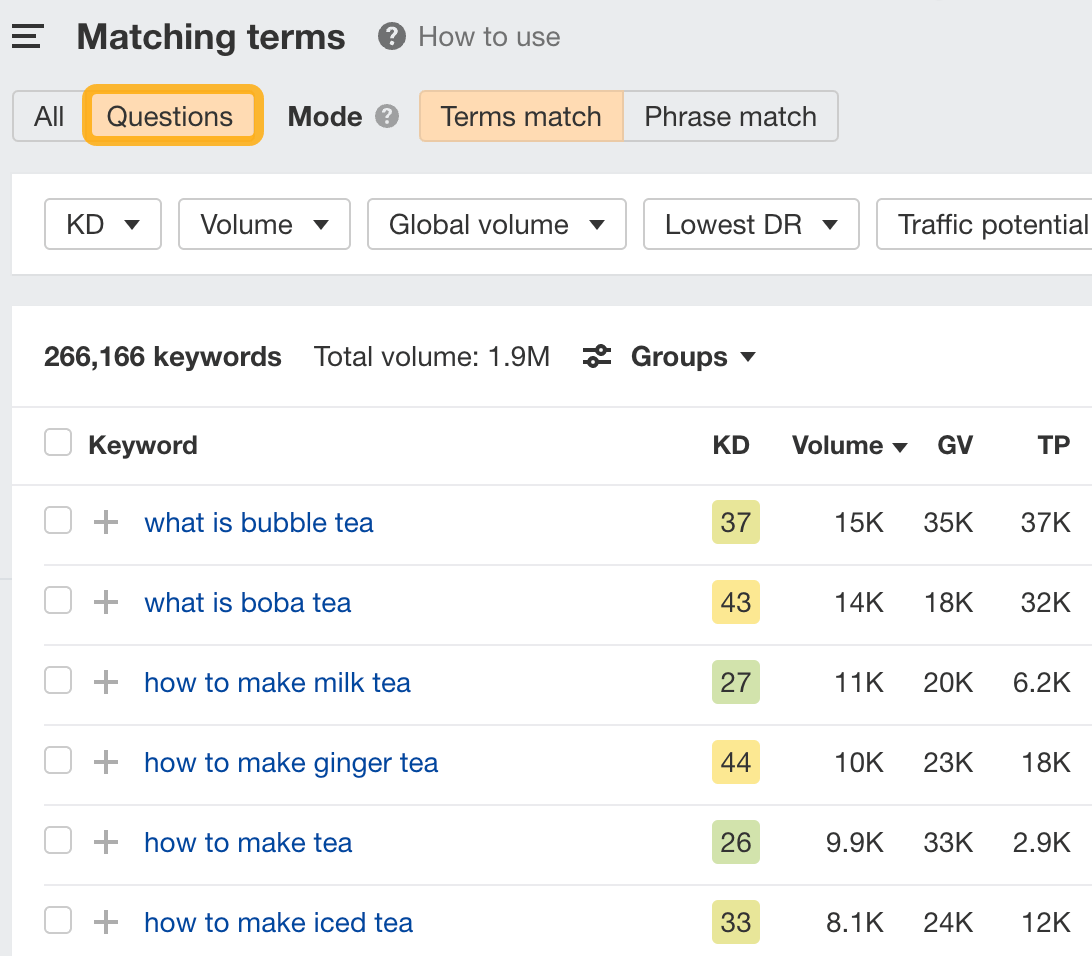
Undergo the checklist and select these related to your web site.
Google needs to serve its customers with essentially the most related content material. It does this by understanding why a searcher is searching for a specific subject. This is called search intent.
If you wish to rank increased on Google, you’ll must match search intent.
To establish search intent, you’ll wish to analyze the three Cs by wanting on the top-ranking pages on your goal key phrase:
- Content material sort – Are they weblog posts, product pages, touchdown pages, or one thing else?
- Content material format – Are they tutorials, listicles, how-to guides, recipes, free instruments, or one thing else?
- Content material angle – Is there a dominant promoting level, like low costs or how simple it is?
For instance, let’s say we’re focusing on the key phrase “find out how to turn out to be a marriage planner”:
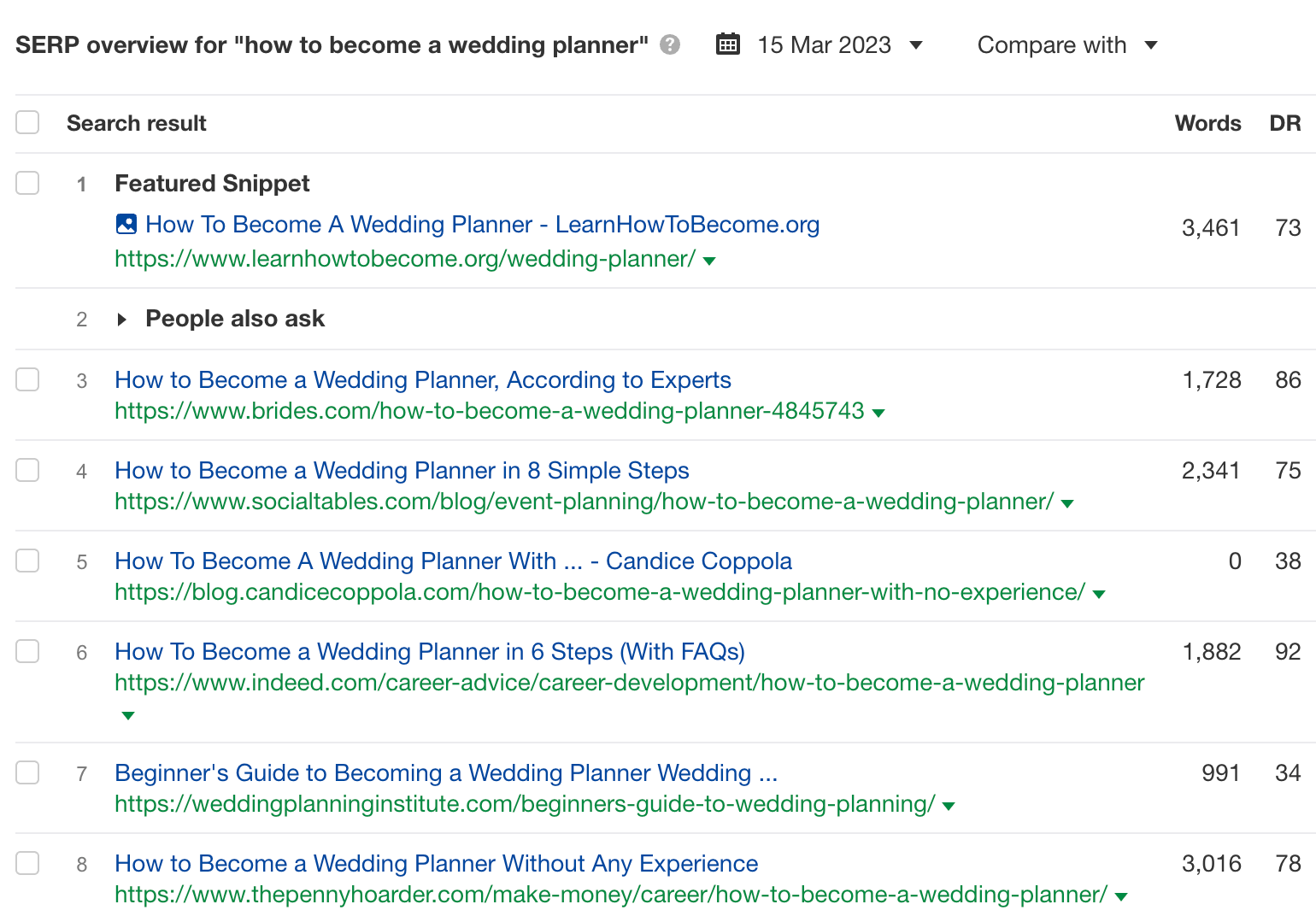
Listed below are the three C’s:
- Content material sort – They’re principally weblog posts.
- Content material format – They’re principally how-tos.
- Content material angle – There are just a few angles right here (“in keeping with specialists,” “variety of steps,” “with none expertise”).
So if you wish to rank for this subject, it’s possible you’ll must create a how-to information (with any of the above angles when you can create one thing higher, or a novel one when you have one thing totally different to share).
If the top-ranking pages cowl related subtopics, they’re possible necessary and what searchers count on to see.
We will discover these subtopics by wanting on the frequent key phrases the top-ranking pages rank for.
Right here’s find out how to discover them:
- Enter your key phrase (e.g., “find out how to turn out to be a marriage planner”) into Ahrefs’ Key phrases Explorer
- Scroll all the way down to the SERP overview
- Choose three to 5 top-ranking articles (ensure they’re related)
- Click on Open in and select Content material hole

Right here, you’ll see the key phrases these pages are rating for. Click on on the Intersection dropdown and select the very best two targets (4, 5). Then look via the outcomes to seek out potential subtopics.

On this instance, searchers wish to know:
- The necessities you might want to turn out to be a marriage planner.
- Whether or not you want a level to turn out to be a marriage planner.
- Should you want a license to be a marriage planner.
- How lengthy does it take to turn out to be a marriage planner.
- The right way to turn out to be a marriage planner with no expertise.
Should you’re focusing on this subject, they’re possible potential subtopics it’s best to cowl.
Featured snippets are fast solutions to look queries displayed on the prime of the SERPs. Right here’s an instance:

Rating for a featured snippet is a “shortcut” to the highest of the SERPs, and it usually has the bonus of driving extra site visitors to your web site.
To optimize for featured snippets, seek for your goal key phrase and see if there’s a featured snippet. If there’s one, you’ll wish to pay attention to what Google is displaying.
Within the above instance, Google reveals a definition for the question “skyscraper method.” And for this reason we’ve included one in our put up:
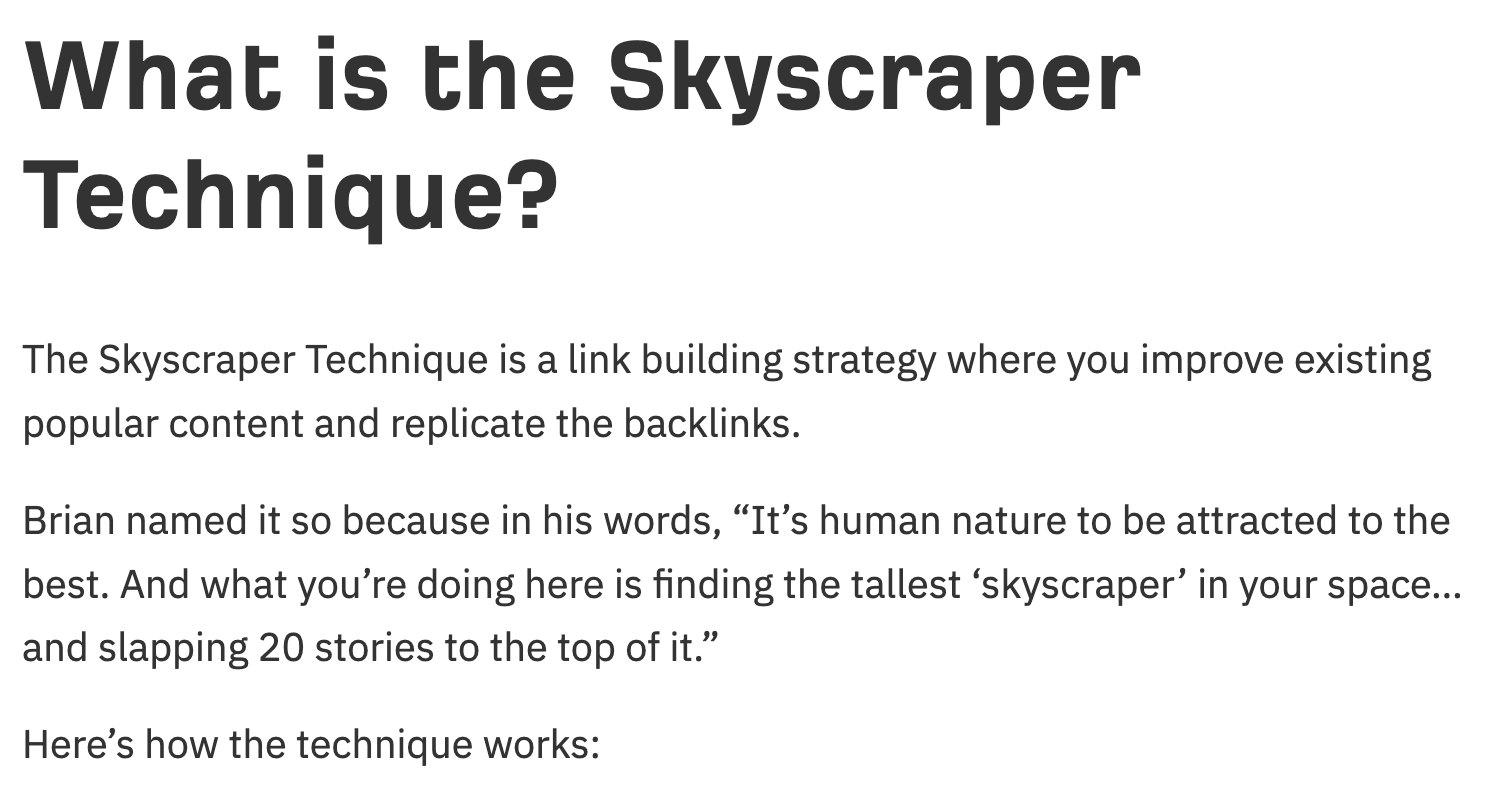
Typically, Google shows a checklist:
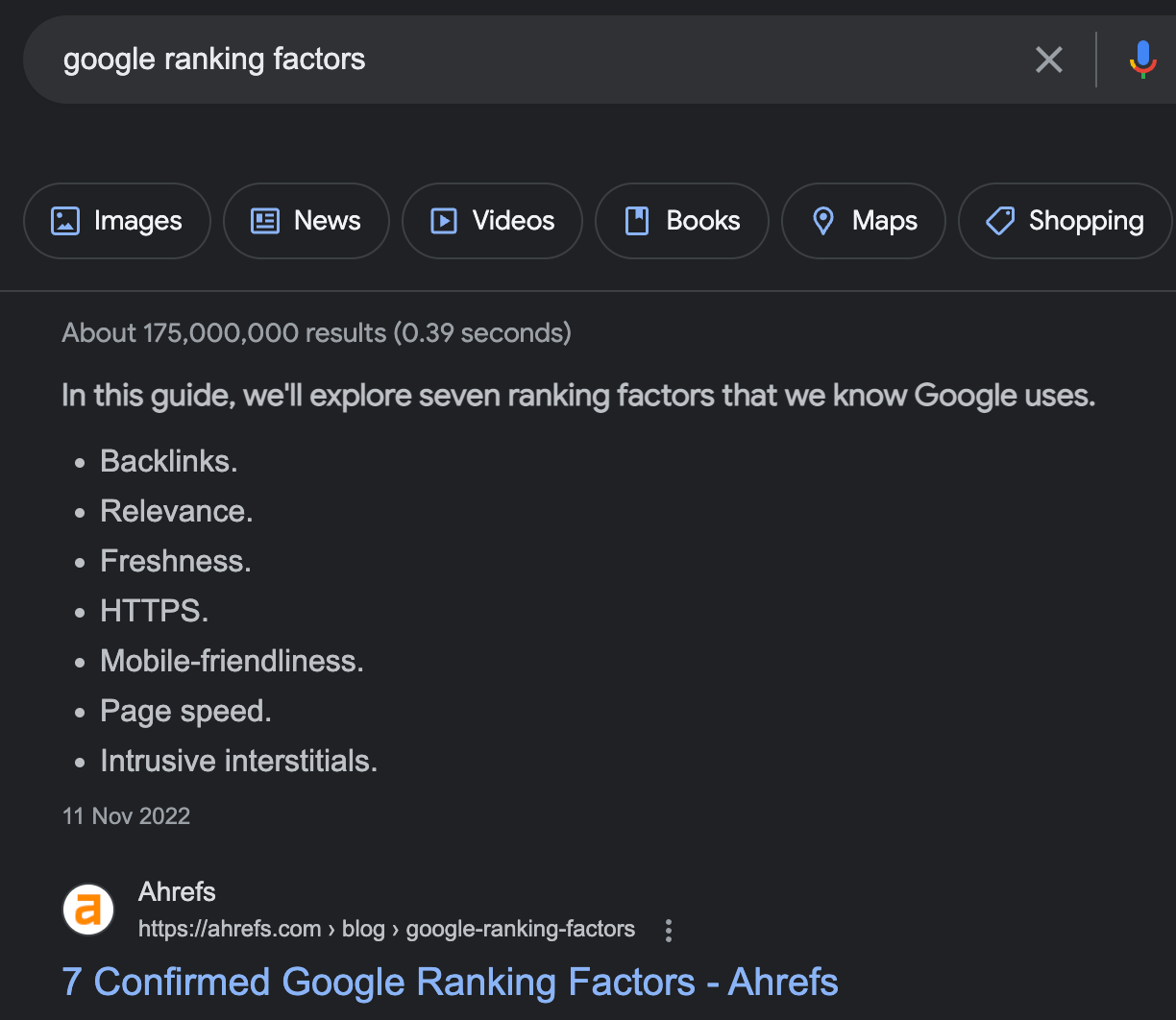
In that case, you’ll wish to format your content material as a listicle too (with correct subheadings).
Hyperlinks are an necessary Google rating issue. Usually talking, the extra folks you will get to hyperlink to your content material, the upper the probability of it performing nicely.

How do you get extra hyperlinks to your put up? You have to give folks a motive to hyperlink to your content material.
Usually, folks hyperlink as a result of there’s one thing distinctive in your content material—both a novel angle otherwise you’ve added distinctive items of knowledge.
Listed below are some concepts on how one can make your content material distinctive:
Google says it makes use of person interplay knowledge to evaluate whether or not search outcomes are related:

In case your put up is tough to learn and your guests bounce—it is probably not nice on your Search engine optimization.
So that you’ll wish to be sure that your content material is as simple on the attention as potential:
- Use descriptive subheadings (H2–H6) for hierarchy
- Use bullet factors to assist with skim studying
- Use pictures and GIFs (the place wanted) to interrupt up the textual content
- Use brief sentences and paragraphs to keep away from “partitions of textual content”
- Use easy phrases that everybody can perceive
- Write such as you converse to make your writing conversational
- Learn your copy out loud (when modifying) to easy the circulation
Google goals to reward pages that show E-E-A-T:
- Expertise – Firsthand or life expertise within the subject.
- Experience – Excessive stage of data or talent in a specific area.
- Authoritativeness – Repute, significantly amongst different specialists and influencers within the business.
- Trustworthiness – Legitimacy, transparency, and accuracy of the web site and its content material.
Put merely: Google rewards content material that shows proof of experience or expertise.
Sidenote.
That is particularly necessary when you’re writing about medical, monetary, or authorized subjects. Google calls these Your Cash or Your Life (YMYL) subjects and requires you to have formal experience.
For instance, most of our weblog content material is created by our advertising and marketing group: a group constructed from SEOs and entrepreneurs with years of expertise. For instance, my colleague, Chris Haines, has 10 years of expertise working in an Search engine optimization company.
Even then, after we’re protecting subjects the place we would not have firsthand expertise, we’ll attain out to specialists. For instance, we interviewed a number of Search engine optimization specialists like Marie Haynes to create an article about Google penalties—a subject that she is well-known to concentrate on.
You’ll wish to do the identical on your content material too.
It may be easy issues like truly utilizing the merchandise you’re reviewing. Or going via a specific course of or process—like truly experiencing intermittent fasting when you’re writing about it.
In any other case, when you would not have experience or expertise, rent somebody who has it to create or assessment your content material.
Inner hyperlinks are necessary for 3 important causes:
- They assist Google uncover new pages.
- They assist Google perceive what your web page is about by way of anchor textual content: the clickable phrases within the hyperlink.
- They move PageRank, which is a crucial Google rating issue.
So not solely do you wish to add inside hyperlinks to different related pages in your web site, however you’ll additionally wish to add them to your newly printed posts too.
The simplest strategy to discover related pages to internally hyperlink to is to carry out a web site search. For instance, if I wish to add inside hyperlinks to my put up on the Skyscraper Method, that is what I’ll search:
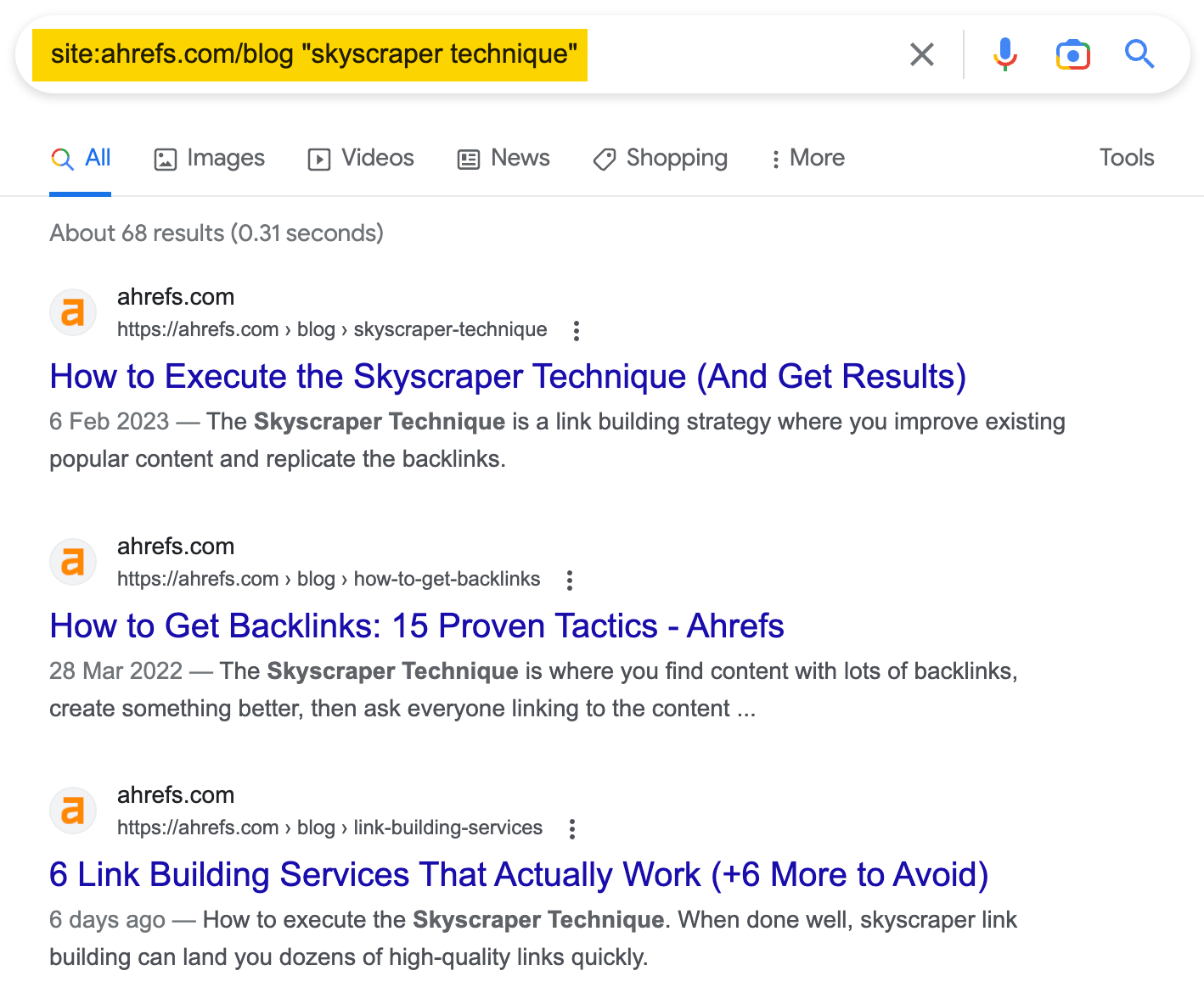
Moreover the primary end result (the precise put up), the remaining are potential targets I can add hyperlinks from.
This technique is generally guide, so a faster manner to do that is to enroll in Ahrefs Webmaster Instruments and run a crawl of your web site with Website Audit. As soon as that’s finished, head to the Hyperlink alternatives report.
The report will counsel potential inside hyperlinks you may add.

In keeping with SparkToro, Google Pictures is the world’s second-largest search engine. Your pictures can rank and ship site visitors your manner too.
Right here’s find out how to optimize them:
- Compress your pictures – This makes file sizes smaller and helps your web page velocity. You should utilize a software like ShortPixel to do this.
- Use descriptive filenames – Google says that filenames give it clues in regards to the picture’s material. Be descriptive and succinct and use dashes between phrases.
- Use descriptive alt textual content – Google additionally makes use of this to grasp the subject material of a picture. Once more, be descriptive and concise. Don’t stuff key phrases.
After looking for a key phrase in Google, the very first thing a person will see is the title tags.

A very good title tag will be the vital distinction between a searcher selecting you or the others.
Right here’s how one can write one which’s click-worthy:
- Maintain them brief – Google usually truncates title tags above 70 characters.
- Match search intent – You’ve finished that in step #2, so ensure your titles mirror that.
- Embody the key phrase – Google makes use of the title to grasp what a web page is about, so attempt to embody your goal key phrase.
- Embody the 12 months – Do that in case your goal subject calls for recent outcomes.
- Use energy phrases – These phrases elicit emotion (e.g., awe-inspiring, fascinating, and many others.). Don’t go overboard—one or two is ok. Use this checklist to seek out ones that match your content material.
- Don’t clickbait – #4 gained’t shock your readers. Clickbait title tags may match within the brief time period however will harm your model in the long run. Deal with your readers as good folks and supply them descriptive and truthful titles.
Google’s advice is to make use of phrases which can be related to your content material. The simplest manner, sometimes, is to make use of your goal key phrase as your slug.
So for a put up focusing on the key phrase “diy web optimization,” the slug will merely be:

Continue to learn
Take a look at these sources to study extra about Search engine optimization:
Any questions or feedback? Let me know on Twitter.
